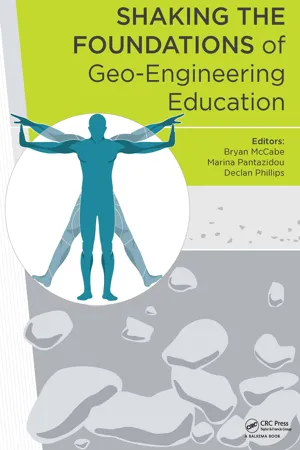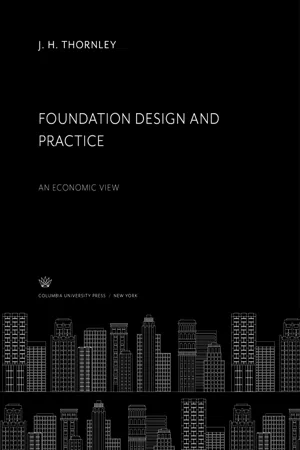Technology & Engineering
Bearing Capacity
Bearing capacity refers to the maximum load that a soil or rock can support without experiencing a failure or excessive settlement. It is a critical consideration in construction and engineering projects to ensure that the foundation of a structure can safely support the anticipated loads. Factors such as soil type, moisture content, and depth play a significant role in determining the bearing capacity of a site.
Written by Perlego with AI-assistance
Related key terms
1 of 5
3 Key excerpts on "Bearing Capacity"
- Bryan McCabe, Marina Pantazidou, Declan Phillips(Authors)
- 2012(Publication Date)
- CRC Press(Publisher)
All groups were 3rd year undergraduate Civil Engineering students as part of a module in Geotechnical Engineering. The effectiveness of the method was evaluated in relation to the teaching and learning of Bearing Capacity. In simple terms Bearing Capacity is the ability of the ground to support the loads transmitted to it from the structures built on it. Being able to calculate the Bearing Capacity of a certain soil under varying loading conditions is a key learning outcome in any geotechnical course. The nature of the subject and the existence of different geotechnical design codes worldwide require adequate knowledge of various def-initions (types) of bearing pressure/capacity. While standard calculations of Bearing Capacity are given in gross terms, considering situations where the founda-tion depth is great it might be important to consider the value of Bearing Capacity in gross effective or net effective terms. The difference between these defini-tions are directly related to the definition of Terzaghi’s principle of effective stress, a corner stone of soil mechanics which is also recognised to be a diffi-cult concept to teach. Similarly, it is of the utmost importance to understand the difference between an allowable Bearing Capacity, an ultimate bearing capac-ity and a presumed Bearing Capacity, especially when referring to accepted values quoted in design codes. The corresponding definitions for these terms are not presented here but they can be found in most textbooks on soil mechanics and foundation engineering. The omission of such definitions should help to empha-size that the teaching method presented in this paper is equally valid for any topic, but it is expected that is particularly effective for engineering subjects. 4.1 Details of module delivery Bearing Capacity is only one of the topics in the mod-ule.- eBook - PDF
- F. G. Bell(Author)
- 2013(Publication Date)
- Newnes(Publisher)
Chapter 5 Foundations for Buildings 5.1 Bearing Capacity Foundation design is primarily concerned with ensuring that movements of a foundation are within limits which can be tolerated by the proposed structure without adversely affecting its functional requirements. Hence the design of a foundation structure requires an understanding of the local geological and ground water conditions and more particularly an appreciation of the various types of ground movement that can occur. In order to avoid shear failure or substantial shear deformation of the ground, the foundation pressures used in design should have an adequate factor of safety when compared with the ultimate Bearing Capacity of the foundation. The ultimate Bearing Capacity is the value of the net loading intensity which causes the ground to fail suddenly in shear. If this is to be avoided then a factor of safety must be applied to the ultimate Bearing Capacity, the value obtained being the maximum safe Bearing Capacity. But even this value may still mean that there is a risk of excessive or differential settlement. Thus the allowable Bearing Capacity is the value which is used in design, this taking into account all possibilities of failure, and so its value is frequently less than that of the safe Bearing Capacity. The value of ultimate Bearing Capacity depends on the type of foundation structure as well as the soil properties. For example, the dimensions, shape and depth at which a footing is placed all influence the Bearing Capacity. More specifically the width of the foundation is important in cohesionless sands, the greater the width the larger the Bearing Capacity whilst in saturated clays it is of little effect. With uniform soil conditions the ultimate Bearing Capacity increases with depth of installation of the foundation structure. - J. H. Thornley(Author)
- 2019(Publication Date)
- Columbia University Press(Publisher)
42 BASIS OF LOAD-CARRYING CAPACITY OF FOUNDATIONS T H E basis of load-carrying capacity of foun-dations may sound like a simple problem. It is not simple. Many partial answers have been given, and the science of soil mechanics offers most of the theories from which the founda-tion engineer should be able to work out the all-inclusive answer. But judging from the number of foundation failures and the end-less series of results which have contradicted the prophesies based on the present theories, it would seem that a lot more thought should be given to the problem. The explanation which follows is not given as a complete or final solution as to how to de-velop foundation bearing values in soil. It is an attempt to pull together in some logical and useful form a number of the theories offered by soil mechanics and to correlate them with field experience. The inadequacy of any presently available theory of foundation bearing, or perhaps the difficulty of applying it, points up sharply the necessity of full-scale field-testing programs as the final court of appeal. The weight placed on field-testing programs leads directly to the need for more dependable and delicate meth-ods of testing to supersede the rough proce-dures now commonly in use. Field testing is discussed in Chapter 23, but the immediate purpose of this chapter is to discuss the factors in soils and foundation structures which un-derlie and govern their bearing values. Resistance of any type of foundation to settlement under load is governed by some or all of the same basic factors. Driven bear-ing piles involve all of the factors, so the fol-lowing study is limited to piling. An under-standing of the problem as applied to pile Bearing Capacity would assure an understand-ing of the simpler problems posed by spread footings, piers, and caissons.
Index pages curate the most relevant extracts from our library of academic textbooks. They’ve been created using an in-house natural language model (NLM), each adding context and meaning to key research topics.


